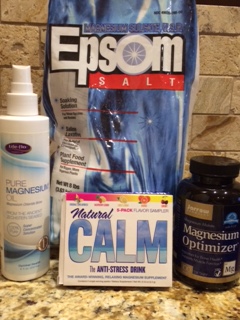Did you know that magnesium is involved in over 300 metabolic processes in your body? I knew it was important for your muscles and bones, but I was blown away by everything else that it does. Magnesium is a mineral used by every organ in your body especially your heart, muscles and kidneys. It helps with thyroid function, lowers adrenalin and cortisol, lowers blood sugar levels, increases serotonin and DHEA and supports testosterone and estrogen production. Arguably, it could be one of the most important minerals in the body. But the reality is that only about 25% of adults are getting the recommended daily amount of magnesium. Which means most of us are low and perhaps even deficient and we probably don’t even know it.
When our levels are low, we may experience some of the following symptoms: muscle pain and spasms, headaches/migraines, insomnia, anxiety/depression, high blood pressure and osteoporosis. I know a lot of these symptoms can be related to other conditions, but it is worth considering that low levels of magnesium may be a contributing factor.
There are many reasons why magnesium deficiency has become more widespread. For starters, the minerals have been depleted from our soil which means they are no longer present in your food. In addition, many people have digestive issues which can interfere with the absorption of minerals from the food they eat. There are even some people who have a genetic predisposition to having low levels of magnesium. Stress and Vitamin D deficiencies can cause an increase in loss of magnesium. Alcohol, sugar and caffeine will dramatically inhibit your magnesium absorption. And, last but not least, Type II diabetes is one of the main causes of magnesium deficiency!
Now that you know what causes magnesium deficiency, what can you do to fix it? You know me, I always prefer to start with food. Spinach and swiss chard are an excellent source of magnesium. Pumpkin seeds, almonds, adzuki beans, avocados, figs, bananas and chocolate also contain magnesium. Juicing your vegetables is probably the best way to make sure you are getting enough magnesium. Honestly, I do not juice very much in the winter because I crave warm, cooked food. However, now that spring has sprung, it is the perfect time for juicing because the greens are in abundance this time of year. Remember, the more green things you eat, the better your magnesium levels will be 😉
Another way to boost your levels is through supplementation. With so many different types of magnesium, it can be difficult to know which one is best. Here is a brief overview to help you decide:
Magnesium Chelate – this is the same magnesium that is in our food; it is highly absorbable;
Magnesium Citrate – often taken for constipation due to its laxative effects;
Magnesium Glycinate – a chelated form making it highly absorbable; a good choice if you are trying to correct an imbalance;
Magnesium Malate – ideal for treating fatigue related conditions;
Magnesium Taurate – magnesium combined with taurine; Taurine is thought to help promote longer lifespans and improve cognitive function and memory;
Magnesium Threonate – penetrates the mitochondria membrane; effective in the treatment of neurodegenerative diseases;
Magnesium Chloride Oil – passes through the skin; good choice for people with malabsorption issues;
Magnesium Sulfate – this is Epsom salt. Taking an Epsom salt bath allows the magnesium to be absorbed through the skin.
Magnesium threonate, taurate and citrate seem to be the best sources because they penetrate cell membranes. Threonate also penetrates the blood-brain barrier so it is great for treating and preventing dementia and improving memory. Magnesium threonate is a synthetic form of magnesium so it tends to be more expensive. Whether you increase your magnesium through food or supplements, make sure you are balancing it with calcium, vitamin D and vitamin K2. This combination of minerals work synergistically so it is important to ensure adequate intake of all of them. As always, before you start adding any supplements to your diet, please check with your healthcare provider to be safe.
The photo below is my magnesium stash! If you have not tried the magnesium oil, I highly recommend it. I like to put it on my legs at night. Not only does it help ward off any leg cramps, it helps me sleep. The Magnesium Optimizer is magnesium taurate. Ever since I watched the Broken Brain docuseries, I have been a little obsessed with boosting my brain and taurine helps with memory. The box of Natural Calm contains 5 individual packets of magnesium citrate and it is a life saver when you are traveling. Just mix one packet with water and feel the stress slip away. And, you will sleep like a baby!
So, there you have it….everything you ever wanted to know about magnesium, but were afraid to ask!! If you still have some questions, hit reply and let’s chat.



